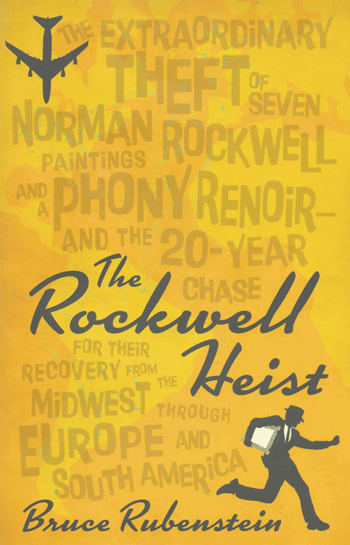The Rockwell Heist: The Extraordinary Theft of Seven Norman Rockwell Paintings and a Phony Renoir — and the 20-Year Chase for Their Recovery from the Midwest through Europe and South America, by Bruce Rubenstein, Borealis Books, 180 pages, $22.95
Reviewed by NEAL GENDLER
Persistence sometimes pays, as Bruce Rubenstein illustrates in recounting a twisty, two-decade quest to recover stolen Norman Rockwell paintings — a case the FBI had let go dormant.
Seven Rockwells and a fake Renoir were stolen from Elayne Galleries in St. Louis Park after a Feb. 16, 1978, showing to 500 invitees ahead of a planned 16-day exhibit. The seven eventually were recovered, five of them thanks mostly to efforts by Elayne and Russ Lindberg’s daughter, Bonnie, her husband, Kevin, and her brother, Gary.
The paintings, then worth about $500,000, were Minnesota’s largest art theft, says Rubenstein, a Twin Cities-based investigative journalist and author.
“The Rockwell paintings were recovered 22 years later, after they had been bought and sold on three continents,” Rubenstein says. By then, once-scorned Rockwell had been “reassessed,” his work soaring in value. The thieves were never charged. Rubenstein says investigators knew their identities, but “couldn’t gather enough evidence to prove it.”
The Rockwell Heist is a quick and engaging story about the theft, strange characters, the loot’s travel, the business of copying art and the serendipity of recovery. Twin Cities-area readers will see some familiar names. Unfamiliar is “Sonia,” the nickname for a beautiful Hispanic flight attendant with questionable contacts in Latin America — where the Rockwells landed — and a cocaine involvement that sent her to prison.

The Excelsior Boulevard gallery was named for Elayne Lindberg, a strong promoter with previous occupations as a department-store detective and a “grapho-analyst,” skilled at spotting forged signatures and assessing character on the basis of handwriting. Familiar with law enforcers and criminals, she tried to help the FBI crack an art-related crime ring in Miami but blew her cover arguing with Sonia. Elayne died in 1994.
Rubenstein says that monetizing stolen art can be difficult, works in the black market typically bringing about 7 percent of their value. In Rubenstein’s account, law enforcers seemed more interested in solving the crime — and maybe cracking a crime ring — than in recovering the paintings.
Rubenstein says he knows the identities of the four likely thieves but won’t name the three still alive for fear of libel. He says the dead suspect is Kent Anderson, of Ham Lake, who an acquaintance called “funnier than his brother Louie,” presumably comedian Louie Anderson. (I saw no word from the comic about this.) The others “are enjoying quiet retirements — one on the East Coast, two in the Twin Cities area,” Rubenstein says.
The Rockwells apparently went to Portugal, perhaps to Argentina, and by 1993 to Brazil, where five were bought by an art historian, collector and owner of a private school — legitimately, he insisted. “The other two appear to have been used by someone [else] as collateral for a loan,” Rubenstein says.
He then lets Bonnie recall how she got the collector’s Rockwells back between 1998 and 2000, but for that, you’ll have to read the book. More than a little risk was involved, and she got a last-minute boost from the reawakened FBI and an assistant U.S. attorney.
The other two Rockwells had been seized in Philadelphia in 1998 from a man trying to sell them to a gallery, purportedly to recover money for a Brazilian bank.
Even with much of three chapters devoted to background about art theft, this is a slim volume, yet one reasonably sufficient. Rubenstein’s economy might be self-discipline, telling the story while seldom bogging down the reader in details and minutia.
Borealis is an imprint of the Minnesota Historical Society Press, which spent wisely to give us photos and large type that also fatten The Rockwell Heist to hardcover size and price. But pennies were pinched foolishly by not providing an index. A chronology would have helped.
Although the story is complex, it’s pretty easy to follow and a lot more fun to read than it must have been to live.
***
Neal Gendler is a Minneapolis writer and editor.
(American Jewish World, 4.12.13)



















